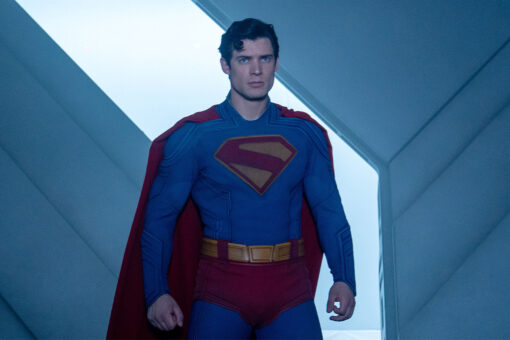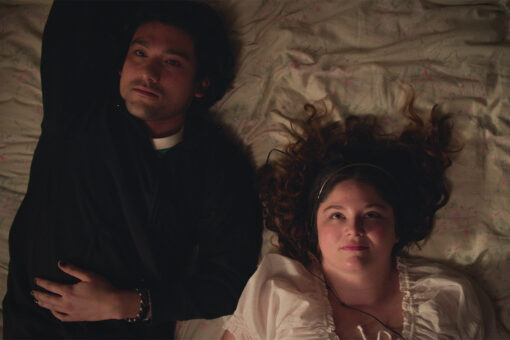“Oh my God. It’s so tantalizing, isn’t it? It’s like being in a treasure hunt,” Andrew Garfield says early on during a recent episode of the British genealogy TV show “Who Do You Think You Are?” “It’s like being Indiana Jones with your own soul.”
He would have no idea how prophetic that sentiment would turn out to be.
The 41-year-old British and American actor has starred in blockbusters from “The Social Network” to “The Amazing Spider-Man” to “Tick, Tick… Boom!” But in the season 22 premiere of “Who Do You Think You Are?,” which came out last week, Andrew Garfield connected with his Jewish roots in a way that he never has before. The result is that he unfurls a family story that has all the cinematic twists and suspense, tragedy and triumph of a Hollywood epic to rival his own filmography.
And, because the episode is currently only available to watch in the United Kingdom, I’m going to recap it in its entirety for you. So buckle up!
The episode begins in London, where Andrew explains that his knowledge of his father’s family tree is stalled at his grandparents, Sam Garfinkel and Doris Mae Savage. He doesn’t know where in Poland his family was from nor why they left, beyond a vague idea of escaping antisemitic persecution. In 2019, Andrew expressed that he has felt “more Jewish” than either British or American. And as evidenced in the show, that still seems to be the case. “I feel a longing to connect more to my Jewish heritage on my dad’s side,” Andrew shares. “I’m really curious about that. There are large parts of my identity that I feel quite far away from and in the pursuit of truth.”
But before Andrew goes on this truth-seeking journey, his dad, Richard, joins him to share family photos and the little information he already has. Richard offers a photo of Andrew’s grandfather Sam as a child with his father, and Andrew teases “those are the Garfinkel ears, for sure.” Richard tells him that Sam’s parents, Ludwig Harry Garfinkel and Sara Cooper (originally Kupcyk) heralded from Kielce in the south of Poland and emigrated to the East End of London shortly after Sam was born. He then shares photos of Ludwig with two unknown women and another photo of an unknown woman with a letter written in Yiddish on the back.
“It would be so good if one of us could read Yiddish. If one of us was a good Jew,” Andrew sighs.
“Unfortunately, neither of us are,” Richard replies.
Armed with these mysterious photographs — and a level of self-deprecation about his Jewish identity that is profoundly Jewish — Andrew heads to Kielce, Poland. First stop: The National Museum of Kielce. “It does feel like a homecoming,” he says as he walks to the museum on the cobblestone streets his family might once have walked. “It feels familiar to me in some mysterious, unknown way.”
There, Andrew meets with Israeli Jewish genealogist Matan Shefi who provides him with a family tree of Ludwig Harry’s siblings and parents. And therein lies the first revelation of the episode. Ludwig Harry westernized his birth name from Aryia Lejbus. And not only that, but his family’s last name is technically Garfinkiel, not Garfinkel. The family tree also shows that Ludwig Harry’s parents were Szmul Aron Garfinkiel and Chaja Guta Szapiro. He was the eldest of five sisters: Szajndla, Dworja, Basia, Estera and Ruchla. And Ludwig also had one brother, Perec, who unfortunately died as a child.
“It’s kind of like pulling up a trap door and finding a whole family line. It’s quite moving,” Andrew described, before turning to the photos he brought. For the first image, featuring Ludwig with two young women, Matan cannot offer anything definitive. He does posit, however, that the image was taken between 1905 and 1909 based on the clothing and therefore the women might be two of Ludwig’s sisters. Andrew then asks about the photograph with the writing on the back, mistakenly calling it Hebrew. “I’m a bad Jew, I’m sorry,” Andrew says after Matan corrects him that the writing is in Yiddish. “I’m trying.”
Matan reassures the Academy Award-nominated actor, “I don’t think there’s such a thing.”
So true, Matan. So true.

After this extremely sweet exchange, Matan translates the back of the photo, sharing that it was postmarked from Warsaw around 1929 or 1930, and that it was a letter from Ludwig’s sister Basia. In it, she wrote explicitly to Ludwig and Andrew’s grandfather, whom she called Sammy, sending her love and asking for news and photographs of them. Andrew remarks that the writing is so loving and mushy, and in turn it makes him a bit emotional. “We are a mushy family,” he tells Matan, inadvertently providing some foreshadowing for the rest of the episode. “We’re an easy cry, the Garfinkiels.”
On his next stop, Andrew mets with Polish historian Katarzyna Person, who takes him both to the former synagogue in Kielce and a building where his family members once lived. Though the synagogue hasn’t been used since the Nazis desecrated its interior, Katarzyna shows Andrew the space as it’s more than likely that his relatives worshipped here. She also uses it as an opportunity to give Andrew a brief history lesson. Between 1905 and 1907, there was a huge wave of anti-Jewish violence in this region of the Russian Empire, she tells him. There were approximately 700 pogroms and over 3,000 Jews were killed. Because Ludwig Harry would likely have been the main breadwinner for his family (his father Szmul died in 1904), this could provide a clue as to why he emigrated with Sara and Sammy in 1910. Perhaps he left for greater and more stable economic opportunity to be able to send money back to his mother and sisters.
Later, in the courtyard of the apartment building where Chaja, Dworja and Estera Garfinkiel lived, Katarzyna gives Andrew more information about the women of his family. By 1930, there’s no record of Szajndla, Basia seems to have been living in Warsaw and Ruchla was living with her husband, Samuel Szpilman, and by 1936 the couple had emigrated to Rio de Janeiro. (Fun fact: Samuel is the cousin of Władysław Szpilman, the musician and Holocaust survivor whose life story is told in the movie “The Pianist.”)
Meanwhile, Chaja, Dworja and Estera all worked as seamstresses until Estera died in 1935 due to “a wasting of muscles.” At that point, Chaja was living by herself and there’s no record of where Dworja was. Katarzyna offers one final document, a death certificate showing that Ruchla Szpilman died in Rio in 1963, leaving behind two sons. Unfortunately, here, the paper trail ceases. If Chaja and Dworja were still in Kielce by 1941, of if any other the other Garfinkiel women had returned, they would have been moved quite literally across the street into the ghetto. As was the case with many victims of the Holocaust, it seems hauntingly likely that Chaja, Dworja, Szajndla and Basia disappeared into the Nazi extermination machine.
“It strikes me, in this moment, that if Ludwig Harry hadn’t decided to leave Kielce with Sammy, little Sammy, my father would have never been born,” Andrew tells Katarzyna. “I would have never been born. My brother would have never been born.”
In search of more information, Andrew hops on a video call with Ruchla’s living son, 92-year-old Adolfo Szpilman, and his daughter, Lydia. Here, he learns some incredible news: Chaja made it to Brazil! Ruchla’s husband Samuel sold his saxophone to pay Chaja’s way to Rio in 1936. Ruchla also kept in contact with at least two of her sisters who, according to Adolfo, were married and living in Warsaw. (This seemingly accounts for Basia, while the other married sister could be either Szajndla or Dworja.) According to the Szpilmans, Ruchla, her husband and her in-laws tried desperately to bring her two sisters to Brazil. But likely due to an antisemitic immigration policy introduced in Brazil in 1937, just one year after Chaja arrived, Ruchla couldn’t secure visas for her sisters. Eventually, Ruchla stopped receiving letters from her sisters, indicating to her that they been murdered by the Nazis.
From here, Andrew makes his hardest journey yet. He visits Treblinka, the extermination camp where Jews who survived the Kielce and Warsaw ghetto were eventually sent to their deaths. Based on Adolfo’s story, it seems likely that Basia and at least one of her other sisters could have died here. “While you’re there, this is very important,” Andrew’s dad tells him over the phone as Andrew’s car approaches the site of where Treblinka once stood, “I’m holding your hand, and your mother’s holding your hand and your brother, when you go in that place.”
Treblinka was completely leveled by the Nazis in 1943 in an effort to hide their war crimes. Now, the land is home to a somber memorial for the 700,000 people who are estimated to have been murdered there. In front of a rock labeled “Kielce,” honoring the victims from the Garfinkiel’s ancestral home, Andrew gets emotional. “That their lives were deemed so valueless,” he says tearfully. “And they were… attempted, the Nazis attempted to erase even the memory of them, even their names, even any record of them. And they had succeeded in a certain way.”
Saying each of their names, Szajndla, Basia and Dworja, he leaves small white stones on top of the Kielce memorial. “This journey we’ve been on has recovered my memory of them and my family’s memory of them and I’m very grateful for that,” he says to camera.
“I wish I had known you better. I wish you peace,” he says to Szajndla, Basia and Dworja.

But from the depths of despair, the next chapter of Andrew Garfield’s Jewish story is one of resilience and triumph. Andrew heads to Los Angeles to learn more about his great-grandmother Sara Kupcyzk’s side of the family. (If you recall, Sara was Ludwig Harry’s wife and the mother of Sam Garfinkel.) At the Wilshire Boulevard Temple, Andrew meets with Caroline Luce, a historian who specializes in the history of Jews in LA. Andrew already knew that the Kupcyzk family first emigrated from Poland to London and then Sara’s brother Harry was the first to move to Los Angeles. There, having westernized his last name to “Cooper,” he opened a high-end ladies garment store in Beverly Hills.
What Andrew learns is that Harry Cooper arrived in the United States on May 15, 1919, and that his parents, five of his siblings, and his sister Sadie’s son Bernard Taper arrived from London in 1922. Caroline imagines that Harry was drawn to Los Angeles because of the booming garment industry associated with Hollywood — perhaps even influencing Harry’s choice to worship at the Wilshire Boulevard Temple where he could rub shoulders with influential network executives.
Next up, Andrew has a quick meeting with Cooper relatives Cathy and Jan. Through their stories, he learns that Harry Cooper’s clientele included Marilyn Monroe, Elizabeth Taylor and Ava Gardner, and Bernard Taper was a successful journalist, writer and scholar. “It’s so wonderful hearing this, that I come from this neurotic need to succeed,” he laughs.
Andrew shares that he feels a mysterious kinship with Bernard, who would’ve been in his grandfather Sam’s generation. So, he goes on one final stop to The Getty Museum. Sitting down with curator Anna Bottinelli, Andrew learns that Bernard was a lieutenant in the United States army during World War II. Not only that, but in 1946, Bernard was sent on a special mission. His goal? Help recover art stolen by the Nazis and search for lost cultural pieces in Bavaria. Put more plainly, Bernard was a Monuments Man, a la the movie “Monuments Men”! Anna tells Andrew that Bernard was selected for this mission at just 28 years old because he spoke and understood German and was a trained investigative journalist. During his time on his mission, Bernard interrogated high power Nazis including Albert Speer, Baldur von Schirach, Walther Funk, Karl Haberstock and Walter Hofer.
“I just love the fact that he was selected to interrogate these war criminals, these murderers,” Andrew tells Anna. “And just the kind of poetic justice of that and his investment in that as a, obviously as a Jew and someone who benefited from his family escaping Poland before WWII, on behalf of his family and on behalf of those that were lost.”
Together, Andrew and Anna visit a painting that Bernard helped recover which now is in the Getty collection. Standing in front of Giambattista Tiepolo’s “Alexander the Great and Campaspe in the Studio of Apelles,” Anna hands Andrew an excerpt of Bernard’s observations on his time as a Monuments Man. Andrew reads aloud, getting emotional once more. “It was good, I thought, that amid all the sickening evidence of men’s depravity and destructiveness I should have had the opportunity to help preserve some of the things that mankind had done that one could not only bear to contemplate but even take joy in.”
Outside the Getty, Andrew overlooks Los Angeles and his journey to learn more about his family has come to an end — at least on “Who Do You Think You Are?” He recounts how he had no idea until now that his family story contained so much: immigration, survival, escape, suffering, extermination, loss, beauty, art, success and healing. “I wasn’t able to feel my belonging without my knowledge of [my family],” Andrew concludes. “It’s shining a light on all of the beauty and the longing and the desire for life that’s come before me. That actually lives in my bones and my blood.”
I told you it was an epic tale, no?



